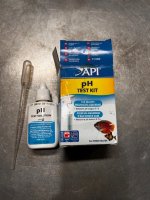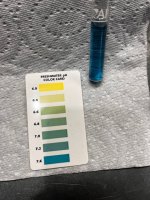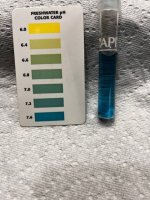As I have posted this year, I have had problems with fungus spring and summer. Someone mentioned it might be my tap water so I tested the pH and this is what I came up with using this kit. From what I am seeing, the pH is at least 7.6. Information on how this level will affect deciduous and conifer bonsai trees is appreciated. I have learned that adding citric acid to the water at the rate of 1 tsp/5 gallons of water will reduce the pH. (thanks Danny). Any other helpful thoughts would be a great. Thank you.
You are using an out of date browser. It may not display this or other websites correctly.
You should upgrade or use an alternative browser.
You should upgrade or use an alternative browser.
pH problem. Advice needed pls
- Thread starter August44
- Start date
bwaynef
Masterpiece
A high pH will decrease nutrient availability and with that comes a myriad of symptoms. Check out the graphic in the pH section of this site:https://lgpress.clemson.edu/publication/interpreting-routine-soil-tests/
WNC Bonsai
Masterpiece
I have a similar water pH and to compensate I alternate using MiracleGro for acid loving plants and Superthrive Grow (previously DynaGro). The MicracleGro helps keep the soil on the acidic side. Superthrive has a good mix of both macro and micronutrients that include iron and manganese which can end up on the low side at higher pH. Below is a list of the nutrients in Superthrive. If I had a large collection I might invest in an automatic dosing system but for 50 trees that seems a bit of overkill and adding citric acid would require hand watering with a watering can all the time. Also you might check with your water supplier as they are required to provide annual quality reports and should be able to give you a more accurate pH value.
Hartinez
Masterpiece
are you on a well august? Or do you use municipal water? If you are on municipal water, you should be able to get a water quality report online. That will tell you a lot. PH is def part of the battle but not always all of it.
Glaucus
Omono
Fungal spores are everywhere. And a pH of 7.8 is perfectly fine for watering almost all plants. This is really a bit vague. Do you have health issues on a bonsai? If so, I'd look into that.
hampton
Shohin
I’m in a similar boat, my water report and ph meter have me at 9.4 and it does seem to cause issues late in the season.
I’m hoping to combat it by collecting rainwater into an IBC tote and using a transfer pump to water everything.
I’m hoping to combat it by collecting rainwater into an IBC tote and using a transfer pump to water everything.
Wood
Chumono
pH of 7.8 is perfectly fine for watering almost all plants.... Do you have health issues on a bonsai?
Not OP, but I'm in the same boat and thinking about getting a Dosatron. My tap water is coming out of the tap at 7.8, ~200ppm TDS. I understand that it's not terrible, but I'm seeing chlorosis from mid-summer on in beech, Japanese maple, Styrax, Korean hornbeam, and several different shitakusa. The beech seem especially sensitive to it. I've currently been fighting it with fertilizer: 2x weekly 75% strength Miracid and 1x weekly fish emulsion. That's been, at best, moderately successful, and I see a return of chlorosis quickly if I don't keep up with it. I started the growing season with Gro-power tablets and teabags of Hollytone, then switched to Osmocote+ when those ran out (mostly to use up the leftover Osmocote I have). I figure that the fertilizer injector will first let me keep the pH low, plus the added benefit of continual fertigation like Andrew Robson does. I'm planning on using MiracleGro + citric acid in the concentrate tank when I get the system set up
Glaucus
Omono
The OP might have a pH as high as 8.5, though. Your pH is neutral and your TDS at 200 should be similar to 0.4 mS/cm. It could be that watering plants in substrate with that gives issues.
Most bonsai people grow in substrate. Having the ability to take sub 50 TDS water, add chemical fertilizer to go towards about 200 TDS, and water with that, while the pH is 6.2 is ideal.
Just googled a Dosatron, but it doesn't remove salts and is 500 USD. I have a canister I can add to my watering can that will mix 2% of whatever is in that canister with the rest of my tap water. It cost me like 50 euro. I can add 0.2 mS/cm EC points or so of liquid fertilizer, or a mild Fe2+-ETDA to my tap water. Theoretically, I could even add acid to the canister and lower the bicarbonate and pH.
The pH experiences by the roots as they try to take up the nutrients is the only thing that maters. And it is affected not by the pH of the tap water, but by the bicarbonate content of the water in combination with the chemistry of the soil or substrate.
Usually with tap water, the issue is removing the sodium chloride and the bicarbonate. And maybe the magnesium. Whatever else is in there, the soil & plant probably can use.
Most bonsai people grow in substrate. Having the ability to take sub 50 TDS water, add chemical fertilizer to go towards about 200 TDS, and water with that, while the pH is 6.2 is ideal.
Just googled a Dosatron, but it doesn't remove salts and is 500 USD. I have a canister I can add to my watering can that will mix 2% of whatever is in that canister with the rest of my tap water. It cost me like 50 euro. I can add 0.2 mS/cm EC points or so of liquid fertilizer, or a mild Fe2+-ETDA to my tap water. Theoretically, I could even add acid to the canister and lower the bicarbonate and pH.
The pH experiences by the roots as they try to take up the nutrients is the only thing that maters. And it is affected not by the pH of the tap water, but by the bicarbonate content of the water in combination with the chemistry of the soil or substrate.
Usually with tap water, the issue is removing the sodium chloride and the bicarbonate. And maybe the magnesium. Whatever else is in there, the soil & plant probably can use.
Glaucus
Omono
Correction, the canister is added to my watering hose. Which means I don't need to mix. That seems like a low tech version of that Dosatron injection device.
Wood
Chumono
I think I'm following along with most of what you're saying, but I was only mediocre at chemistry in high school. pH is really a proxy of CO3^2-, HCO3^-, and OH^-, but the one that is detrimental to plants is HCO3^-? Without a reverse osmosis system, I'm not entirely sure what I could do to deal with total alkalinity, thus the citric acid additions. Is pH a decent enough proxy that using citric acid will provide some kind of improvement? To double check that the pH adjustment will help solve my issues, I've been watering the stressed plants with a watering can plus a small amount of vinegar, and double checking with my pH meter before watering. I've started to see a slight improvement in the two weeks since I started, which I found encouraging
I'm not particularly out there in my substrate choices. Most of the trees are in 1 part potting soil, 1 part perlite for development. Most of the others are akadama and pumice, or Aoki blend. The shitakusa are a mix of Aoki blend and potting soil
Are you using a siphon/Venturi fertilizer injector? The fertilizer injector is definitely a luxury that is technical overkill, but I had already been wondering about getting one for fertilizing anyway
I'm not particularly out there in my substrate choices. Most of the trees are in 1 part potting soil, 1 part perlite for development. Most of the others are akadama and pumice, or Aoki blend. The shitakusa are a mix of Aoki blend and potting soil
Are you using a siphon/Venturi fertilizer injector? The fertilizer injector is definitely a luxury that is technical overkill, but I had already been wondering about getting one for fertilizing anyway
WNC Bonsai
Masterpiece
Rainwater brings its own issues. In your area acid rain is still a factor plus rain is very dilute so you need to compensate with your nutrients. Harry Harrington recently did a video on his experiences after switching to rainwater.I’m in a similar boat, my water report and ph meter have me at 9.4 and it does seem to cause issues late in the season.
I’m hoping to combat it by collecting rainwater into an IBC tote and using a transfer pump to water everything.
hampton
Shohin
thanks for the link, I’ll give this a watch.Rainwater brings its own issues. In your area acid rain is still a factor plus rain is very dilute so you need to compensate with your nutrients. Harry Harrington recently did a video on his experiences after switching to rainwater.
After a cursory look it seems like New England rainfall may have the opposite effect - average ph seems to be around 4.5.
I wonder if it is easier to keep a tank at neutral ph than some sort injection system to combat the basic city water. If you have any other information it’s certainly appreciated
Thanks for the comments and the link. I only tested the water for pH and not the soil as I use different kinds of soils and a lot of my trees are collected and still have native soil around their roots so the soil pH is going to vary a lot from one plant to another. Maybe you could comment about this?A high pH will decrease nutrient availability and with that comes a myriad of symptoms. Check out the graphic in the pH section of this site:https://lgpress.clemson.edu/publication/interpreting-routine-soil-tests/
WNC Bonsai
Masterpiece
Sorry, I forgot to include the Superthrive nutrient table.I have a similar water pH and to compensate I alternate using MiracleGro for acid loving plants and Superthrive Grow (previously DynaGro). The MicracleGro helps keep the soil on the acidic side. Superthrive has a good mix of both macro and micronutrients that include iron and manganese which can end up on the low side at higher pH. Below is a list of the nutrients in Superthrive. If I had a large collection I might invest in an automatic dosing system but for 50 trees that seems a bit of overkill and adding citric acid would require hand watering with a watering can all the time. Also you might check with your water supplier as they are required to provide annual quality reports and should be able to give you a more accurate pH value.

That's sure a lot different than what superthrive used to be. When did that change. Looks like a good product now.
No well, municipal only. Will check water quality report and see what it is. Thanksare you on a well august? Or do you use municipal water? If you are on municipal water, you should be able to get a water quality report online. That will tell you a lot. PH is def part of the battle but not always all of it.
WNC Bonsai
Masterpiece
It used to be DynaGro but last year changed to Superthrive. I don’t think that the formula changed, only the name.That's sure a lot different than what superthrive used to be. When did that change. Looks like a good product now.
WNC Bonsai
Masterpiece
I bet if you called them up their lab techs would be able to tell you how much variability there is in the pH measurements. They basically adjust the pH to counter pipe erosion so shoot for something circumneutral and they adjust the alkalinity to compensate. They might also be able to tell you things like calcium and magnesium which aren’t usually in the actual report, just hardness. My report just gives the annual average pH.No well, municipal only. Will check water quality report and see what it is. Thanks
And you could be correct. I always wondered about the 1/2 tsp per gallon thing. That does not seem to me very much of the product.It used to be DynaGro but last year changed to Superthrive. I don’t think that the formula changed, only the name.
MaciekA
Shohin
I think I'm following along with most of what you're saying, but I was only mediocre at chemistry in high school. pH is really a proxy of CO3^2-, HCO3^-, and OH^-, but the one that is detrimental to plants is HCO3^-? Without a reverse osmosis system, I'm not entirely sure what I could do to deal with total alkalinity, thus the citric acid additions. Is pH a decent enough proxy that using citric acid will provide some kind of improvement? To double check that the pH adjustment will help solve my issues, I've been watering the stressed plants with a watering can plus a small amount of vinegar, and double checking with my pH meter before watering. I've started to see a slight improvement in the two weeks since I started, which I found encouraging
I'm not particularly out there in my substrate choices. Most of the trees are in 1 part potting soil, 1 part perlite for development. Most of the others are akadama and pumice, or Aoki blend. The shitakusa are a mix of Aoki blend and potting soil
Are you using a siphon/Venturi fertilizer injector? The fertilizer injector is definitely a luxury that is technical overkill, but I had already been wondering about getting one for fertilizing anyway
There is a middle ground for a two digit price: the EZFlow injector. I’ve used the dosatron setups at Hagedorn’s and at Rakuyo and done the whole TDS/EC thing there. It all transfers perfectly to an $80 EZFlow. I’ve got two of them on two different bibs.
Note though: I don’t acidify except by way of the mild acidification via the fish fertilizer. A doseatron might be a better way to inject something like miracid since the reservoir can be as huge as you want to maintain a consistent acidity between dose adjustments
Similar threads
- Replies
- 11
- Views
- 1K
- Replies
- 9
- Views
- 527



